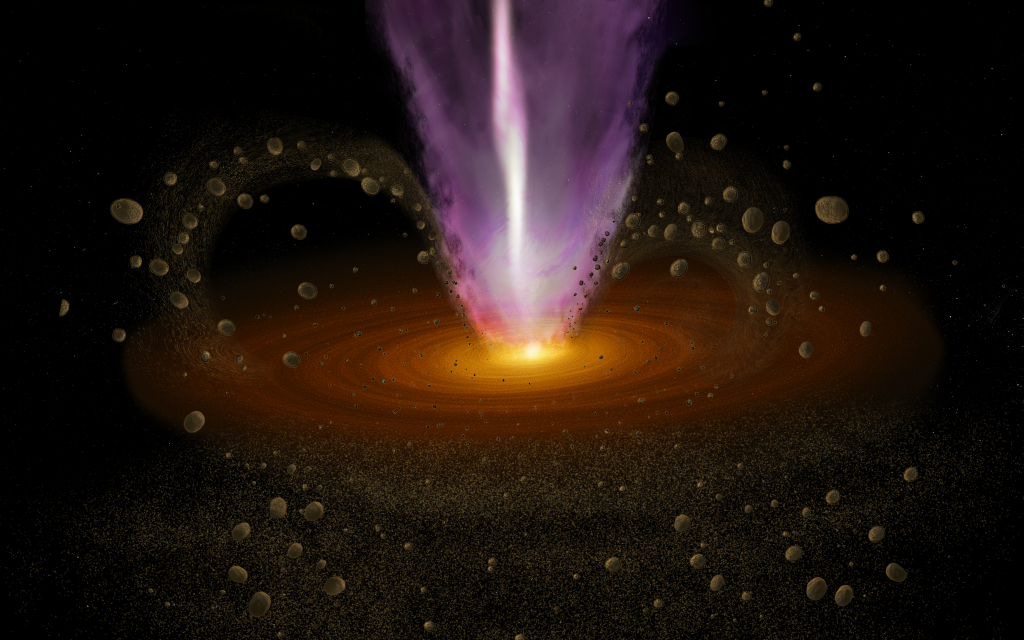The U.S. National Science Foundation National Radio Astronomy Observatory (NSF NRAO), in partnership with several leading Mexican universities and research institutes, has announced a series of landmark agreements and meetings aimed at advancing Mexico’s role in the Next Generation Very Large Array (ngVLA) project.
Recent News
Astronomers Discover a Superheated Star Factory in the Early Universe
Astronomers have uncovered a previously unknown, extreme kind of star factory by taking the temperature of a distant galaxy using the ALMA telescope. The galaxy is glowing intensely in superheated cosmic dust while forming stars 180 times faster than our own Milky Way.
Astronomers Share Largest Molecular Survey To-date: GOTHAM Legacy Data Goes Public
Astronomers in the “GBT Observations of TMC-1: Hunting Aromatic Molecules” research survey, known as GOTHAM, have released a spectral line survey with largest amount of telescope time ever conducted, charting more than 100 molecular species only found in deep space.
From Stardust to Stone: Windswept Grains Hold Clues to Planet’s Beginnings

Astronomers discover that stellar winds help dust grains grow into planet-building pebbles, offering fresh insight into the origins of rocky planets like Earth
The Atacama Large Millimeter/submillimeter Array (ALMA) has uncovered a key piece of the puzzle in how rocky planets, such as Earth, form around young stars. For decades, scientists have struggled to explain how dust grains in the disks around newborn stars grow from tiny dust grains to planet-building “pebbles” without either spiraling into the star or shattering in collisions—a challenge known as the “meter-size barrier.”
A team of more than 50 astronomers and chemists from the world’s leading scientific institutes used ALMA for this large program of research, known as the “Fifty AU STudy of the chemistry in the disk/envelope systems of Solar-like protostars” or FAUST. The team studies the chemistry of the dense molecular gas in the envelopes of a representative sample of Solar-like protostars, and now, for the first time ever, have directly observed millimeter-sized dust grains—about 10,000 times larger than typical interstellar dust—embedded in the walls of a protostellar outflow cavity. These grains appear to have been lifted from the dense inner protostellar disk by winds and then deposited farther out, away from where they can fall back onto the disk, and continue growing. This process gives the grains more time and space to stick together, potentially overcoming a long-standing barrier to planet formation.
Astronomers directly observed these millimeter-sized dust grains in the walls of the protostellar outflow cavity of the young L1551 IRS5 binary system, showing these grains can grow much larger than previously thought in the early stages of planet formation. These findings offer new insight into the processes that may have led to the formation of our own Solar System and highlight a previously underestimated pathway for planet formation.
“This discovery not only provides a new mechanism for building planets but also offers a glimpse into how our own Solar System may have formed,” said Giovanni Sabatini, a scientist with the National Institute for Astrophysics (INAF) at the Arcetri Astrophysical Observatory in Florence, and leader of this research. “The findings open exciting new questions about the diversity of planetary systems in our galaxy and bring us closer to understanding our cosmic origins,” adds Claire Chandler, NSF NRAO scientist and a co-PI of the FAUST collaboration.
About NRAO
The National Radio Astronomy Observatory (NRAO) is a facility of the U.S. National Science Foundation, operated under cooperative agreement by Associated Universities, Inc.
About ALMA
The Atacama Large Millimeter/submillimeter Array (ALMA), an international astronomy facility, is a partnership of the European Southern Observatory (ESO), the U.S. National Science Foundation (NSF) and the National Institutes of Natural Sciences (NINS) of Japan in cooperation with the Republic of Chile. ALMA is funded by ESO on behalf of its Member States, by NSF in cooperation with the National Research Council of Canada (NRC) and the National Science and Technology Council (NSTC) in Taiwan and by NINS in cooperation with the Academia Sinica (AS) in Taiwan and the Korea Astronomy and Space Science Institute (KASI).
ALMA construction and operations are led by ESO on behalf of its Member States; by the National Radio Astronomy Observatory (NRAO), managed by Associated Universities, Inc. (AUI), on behalf of North America; and by the National Astronomical Observatory of Japan (NAOJ) on behalf of East Asia. The Joint ALMA Observatory (JAO) provides the unified leadership and management of the construction, commissioning and operation of ALMA.
This news article was originally published on the NRAO website on June 12, 2025.
Recent News
NSF National Radio Astronomy Observatory and Mexican Institutions Sign Historic Agreements to Advance ngVLA Collaboration
The U.S. National Science Foundation National Radio Astronomy Observatory (NSF NRAO), in partnership with several leading Mexican universities and research institutes, has announced a series of landmark agreements and meetings aimed at advancing Mexico’s role in the Next Generation Very Large Array (ngVLA) project.
Astronomers Discover a Superheated Star Factory in the Early Universe
Astronomers have uncovered a previously unknown, extreme kind of star factory by taking the temperature of a distant galaxy using the ALMA telescope. The galaxy is glowing intensely in superheated cosmic dust while forming stars 180 times faster than our own Milky Way.
Astronomers Share Largest Molecular Survey To-date: GOTHAM Legacy Data Goes Public
Astronomers in the “GBT Observations of TMC-1: Hunting Aromatic Molecules” research survey, known as GOTHAM, have released a spectral line survey with largest amount of telescope time ever conducted, charting more than 100 molecular species only found in deep space.
